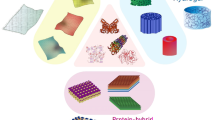Abstract
One of the major challenges facing researchers of tissue engineering is scaffold design with desirable physical and mechanical properties for growth and proliferation of cells and tissue formation. In this research, firstly, nano-bioglass powder with grain sizes of 55–56 nm was prepared by melting method of industrial raw materials at 1,400 °C. Then the porous ceramic scaffold of bioglass with 30, 40 and 50 wt% was prepared by using the polyurethane sponge replication method. The scaffolds were coated with poly-3-hydroxybutyrate (P3HB) for 30 s and 1 min in order to increase the scaffold’s mechanical properties. XRD, XRF, SEM, FE-SEM and FT-IR were used for phase and component studies, morphology, particle size and determination of functional groups, respectively. XRD and XRF results showed that the type of the produced bioglass was 45S5. The results of XRD and FT-IR showed that the best temperature to produce bioglass scaffold was 600 °C, in which Na2Ca2Si3O9 crystal is obtained. By coating the scaffolds with P3HB, a composite scaffold with optimal porosity of 80–87 % in 200–600 μm and compression strength of 0.1–0.53 MPa was obtained. According to the results of compressive strength and porosity tests, the best kind of scaffold was produced with 30 wt% of bioglass immersed for 1 min in P3HB. To evaluate the bioactivity of the scaffold, the SBF solution was used. The selected scaffold (30 wt% bioglass/6 wt% P3HB) was maintained for up to 4 weeks in this solution at an incubation temperature of 37 °C. The XRD, SEM EDXA and AAS tests were indicative of hydroxyapatite formation on the surface of bioactive scaffold. This scaffold has some potential to use in bone tissue engineering.
















Similar content being viewed by others
References
Hutmacher DW. Scaffolds in tissue engineering bone and cartilage. Biomaterials. 2000;21:2529–43.
Gomes MA. Bone tissue engineering strategy based on starch scaffolds and bone marrow cells cultured in a flow perfusion bioreactor. PhD thesis. 2004;1:25–34.
Lanza R, Langer R, Vacanti J. Principle of tissue engineering. 3rd ed. San Diego: Academic Press; 2007.
Jeffrey O, Thomas A, Bruce A, Charles S. Bone tissue engineering. 4th ed. Boca Raton: CRC Press; 2005.
Sehrooten J, Helsen JA. Adhesion of bioactive glass coating to Ti6Al4V oral implant. Biomaterials. 2000;21:46–191.
Jones DA. Principles and prevention of corrosion. Singapore: MacMillan Publishing Company; 1992.
Hajiali H, Karbasi S, Hosseinalipour M, Rezaie H. Effects of bioglass nanoparticles on bioactivity and mechanical property of poly(3hydroxybutirate) scaffolds. Scientia Iranica. 2013;20:2306–13.
Schüth F, Sing KSW, Weitkamp J. Handbook of porous solids: gelcasting foams for porous ceramics. Columbus: American Ceramic Society Bulletin; 2002. p. 2423–970.
Akaraonye E, Keshavarz T, Roy I, Chem J. Production of polyhydroxyalkanoates. J Chem Technol Biotechnol. 2010;85:732–43.
Misra SK, et al. poly(3-hydroxybutyrate) multifunctional composite scaffolds for tissue engineering applications. Biomaterials. 2010;31:2806–15.
Li W, Laurencin C, Caterson E, Tuan R, Ko F. Electrospun nanofibrous structure: a novel scaffold for tissue engineering. J Biomed Mater Res. 2002;60:613–21.
Knowles JC, Hastings GW. Development of a degradable composite for orthopaedic use. Biomaterials. 1992;13:491–6.
Bretcanu O, et al. Biodegradable polymer coated 45S5 Bioglass-derived glass-ceramic scaffolds for bone tissue engineering. Eur J Glass Sci Technol. 2007;48:227–34.
Foroughi M, Karbasi S, Ebrahimi-Kahrizsangi R. Physical and mechanical properties of a poly-3-hydroxybutyrate coated nanocrystalline hydroxyapatite scaffold for bone tissue engineering. J Porous Mater. 2012;19:667–75.
Saadat A, Behnamghader AA, Karbasi S, Abedi D, Soleimani M, Shafiee A. Comparison of acellular and cellular bioactivity of poly 3-hydroxybutyrate/hydroxyapatite nanocomposite and poly 3-hydroxybutyrate scaffolds. J Biotechnol Bioprocess Eng. 2013;18:587–93.
Ramay H, Zhang M. Preparation of porous hydroxyapatite scaffolds by combination of the gel-casting and polymer sponge methods. Biomaterials. 2003;24:3293–302.
Chen QZ, Thompson ID, Boccaccini AR. 45S5 bioglass-derived glass ceramic scaffolds for bone tissue engineering. Biomaterials. 2006;27:2414–25.
Hodgskinson R, Currey JD. Effect of variation in structure on Young’s modulus of cancellous bone. J Eng Med. 1986;204:115–21.
Hing KA, Best SM, Bonfield W. Characterization of poroushydroxyapatite. J Mater Sci. 1999;10:135–45.
Kokubo T, Takadama H. How useful is SBF in predicting in vivo bone bioactivity? Biomaterials. 2006;27:2907–15.
Hench LL. The story of bioglass. J Mater Sci. 2006;17:967–78.
Monshi A, Foroughi MR, Monshi MR. Modified Scherrer equation to estimate more accurately nano-crystallite size using XRD. World J Nano Sci Eng. 2012;2:154–60.
Boskey A, Camacho N. FT-IR imaging of native and tissue engineered bone and cartilage. Biomaterials. 2006;28:2465–78.
Zin-Kook K, Jeong-Jung O, Hisamichi K. Achitecture of porous hydroxyapatite scaffolds using polymer foam process. J Biomech Sci Eng. 2009;4:377–83.
Murphy CM, Brien MG. The effect of mean pore size on cell attachment proliferation and migration in collagen glycosaminoglycan scaffolds for bone tissue engineering. Biomaterials. 2010;31:461–6.
Callcut S, Knowles JC. Correlation between structure and compressive strength in a reticulate glass-reinforced hydroxyapatite foam. J Mater Sci Mater Med. 2002;13:485–9.
Chen QZ, Boccaccini AR. Poly(dl-lactide) coated 45S5 bioglass-based scaffolds: processing and characterisation. J Biomed Mater Res. 2006;77:445–52.
Landi E, Tampieri A, Celotti G, Sprio S. Densification behaviour and mechanisms of synthetic hydroxyapatites. J Eur Ceram Soc. 2000;20:2377–87.
Author information
Authors and Affiliations
Corresponding author
Rights and permissions
About this article
Cite this article
Montazeri, M., Karbasi, S., Foroughi, M.R. et al. Evaluation of mechanical property and bioactivity of nano-bioglass 45S5 scaffold coated with poly-3-hydroxybutyrate. J Mater Sci: Mater Med 26, 62 (2015). https://doi.org/10.1007/s10856-014-5369-z
Received:
Accepted:
Published:
DOI: https://doi.org/10.1007/s10856-014-5369-z




